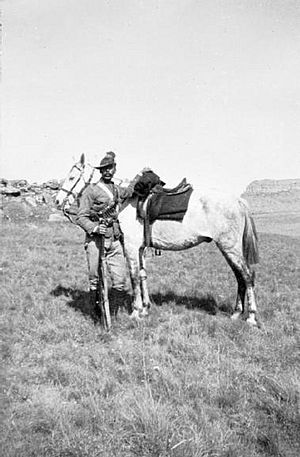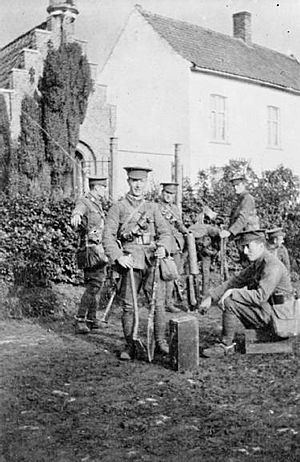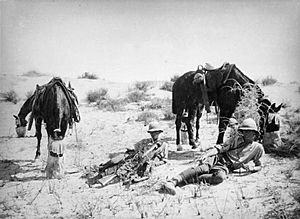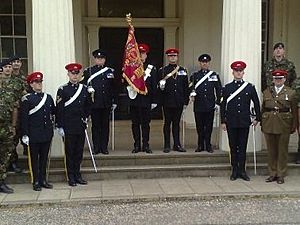British yeomanry during the First World War facts for kids
The British yeomanry during the First World War were special soldiers in the British Army. They were like a reserve force, ready to help when needed. In 1914, when the war started, there were 57 yeomanry regiments and 14 mounted brigades. These groups were made up of soldiers who rode horses.
Soon after the war began, more regiments were created. Some of these new groups were later combined to provide replacement soldiers for both the cavalry (regular horse soldiers) and the yeomanry. Other horse-riding soldiers in the British Army included regular cavalry regiments and three special reserve regiments.
Some yeomanry regiments were very old, going back over 100 years. The oldest, the Royal Wiltshire Yeomanry, started in 1794. The newest, the Welsh Horse, was formed just after the war began in August 1914.
To make the yeomanry bigger, new "mirror" regiments and brigades were formed. For example, the Yorkshire Hussars became the 1/1st Yorkshire Hussars when a second group, the 2/1st Yorkshire Hussars, was created. Mounted brigades often changed their names or were split up.
Before the war, there were no large yeomanry divisions. But after the war started, mounted brigades were put into special mounted divisions. Some regiments also fought alongside regular cavalry. Others were assigned to infantry divisions or army groups as their horse-riding units.
The yeomanry fought in many different parts of the war. On the Western Front, they first fought on horseback. But during the Gallipoli Campaign, the 2nd Mounted Division fought on foot. Later, the yeomanry fought on the Macedonian front as part of the British Salonika Army, where they rode horses again.
More horse-riding actions happened with the Egyptian Expeditionary Force in the Sinai and Palestine Campaign. Some yeomanry regiments had different roles during the war. Some became bicycle units, while others became infantry battalions (foot soldiers). For example, the 1/1st Yorkshire Hussars ended the war as the 9th (Yorkshire Hussars Yeomanry) Battalion.
Several regiments in the Middle East became infantry and formed the 74th (Yeomanry) Division. This division then fought in Palestine before moving to France. In 1918, other yeomanry regiments went to the Western Front to form machine gun battalions. By the end of the war, over 3,800 yeomanry soldiers had died.
Contents
What Was the Yeomanry?
The British yeomanry was first created in the 1790s to defend Britain at home. At that time, most yeomanry soldiers were farmers. They were expected to bring their own horse and saddle.
In their early years, the yeomanry were sometimes involved in public order events, like the Peterloo Massacre in 1819 and the Bristol riots in 1831.
At first, the size and structure of yeomanry groups varied a lot. By the 1800s, there were only about 1,500 men across the country. But fears of new wars in France led to a big increase in their numbers by the mid-1800s. Back then, yeomanry volunteers had to provide their own weapons. They also had to train for 24 days a year.
From 1896, the yeomanry were given Lee–Metford or Lee–Enfield carbines (short rifles). These could shoot effectively up to 600 yards. However, the Mauser rifles used by their enemies in the Second Boer War could shoot over 2,000 yards.
After the Second Boer War began, the British government asked for volunteers. About 10,000 men joined the Imperial Yeomanry. At that time, the total strength of all yeomanry regiments was around 8,800. About 2,200 of them volunteered for the Imperial Yeomanry.
After the war, in 1905, Richard Haldane, who was in charge of the army, started to reorganize it. The Haldane Reforms and a new law in 1907 helped the British Army create a force ready to go overseas. This law also meant that soldiers in the Territorial Force (which the yeomanry was part of) received regular pay and training. This training included a two-week camp every year.
Because of these changes, when the Territorial Force was formed, it was decided there would be 14 mounted brigades. Each brigade had three yeomanry regiments, an artillery unit, and other support groups.
Yeomanry Soldiers and Their Gear
In 1914, a British yeomanry regiment had 26 officers and 523 other soldiers. The main leader was a lieutenant colonel, with a major as the second in command. Other officers helped with things like supplies, signals, and medical care.
Forty-eight men were part of the regiment's headquarters. Twenty-seven men were in the machine gun section, which had two Vickers Machine Guns. In 1909, it was suggested that each regiment should have six machine guns, but this was not approved due to cost.
The remaining 474 men were in the regiment's three squadrons. Each squadron had four troops. A squadron was led by a major and had 158 men, including officers, sergeants, and privates. A troop had one officer and about 30 other soldiers.
To care for the horses, the regiment had a veterinary officer and other specialists like farriers (who put shoes on horses) and saddlers. Each squadron had two saddlers, and each troop had a shoeing smith.
A yeomanry regiment had 528 riding horses, 74 draught horses (for pulling carts), 6 pack horses, 18 carts, and 15 bicycles.
British yeomanry soldiers were armed with a 1908 pattern sword and Lee–Enfield rifles. Unlike their French and German enemies, who often had shorter-range carbines. As the war went on, yeomanry soldiers were given brodie helmets (steel helmets), hand grenades, trench mortars, and Hotchkiss light machine guns.
Like the infantry, they wore khaki uniforms and a service dress cap. Instead of infantry webbing, they carried their ammunition in a bandolier (a belt with pockets for bullets).
Yeomanry in Major Campaigns
In August 1914, the 1st Mounted Division was formed. In September 1914, the 2nd Mounted Division was created. There were also a 3rd Mounted Division and a 4th Mounted Division for the second line brigades.
The only yeomanry division to fight in active service was the 2nd Mounted Division. This division fought in the Gallipoli Campaign starting in August 1915. By September, many soldiers were injured or killed, so the division had to reorganize. The remaining soldiers formed new brigades and were reinforced by other units. In December, the survivors were sent to Egypt, and the division was disbanded in January 1916.
The regiments then served in the Sinai and Palestine Campaign. They formed several new brigades. These brigades served in the Imperial Mounted Division and the ANZAC Mounted Division. Later, they were reorganized into the 4th and 5th Cavalry Divisions. The brigades in these two cavalry divisions had one yeomanry regiment and two British Indian Army cavalry regiments. The 7th Mounted Brigade also served on its own with the British Salonika Army on the Macedonian front.
Other yeomanry regiments that fought at Gallipoli and then went to Egypt were formed into dismounted brigades. They were sent to defend the Suez Canal. Eighteen regiments were then turned into twelve infantry battalions and joined the 74th (Yeomanry) Division in March 1917. This division fought in several battles in the Sinai before moving to France.
Brave Actions: Victoria Cross Recipients
The Victoria Cross is the highest award for bravery in the face of the enemy in the United Kingdom. Six yeomanry soldiers received this award during the First World War.
The first award went to Private Fred Potts of the Berkshire Yeomanry on August 21, 1915, during the Battle of Scimitar Hill in the Gallipoli Campaign.
Lance-Corporal Harold Sandford Mugford of the Essex Yeomanry received the second award on April 11, 1917, during the Battle of Arras.
Major Alexander Malins Lafone of the Duke of Cambridge's Hussars was awarded for his actions on October 27, 1917, in the Battle of El Buggar Ridge.
In 1918, there were three more awards:
- Private Harold Whitfield, 10th (Shropshire and Cheshire Yeomanry) Battalion, King's Shropshire Light Infantry, on March 10, 1918, during the Battle of Tell 'Asur in Palestine.
- A posthumous (after death) award to Acting Lieutenant-Colonel Oliver Cyril Spencer Watson of the Duke of Cambridge's Hussars, on March 28, 1918, at Rossignol Wood during the German spring offensive in France.
- Sergeant Thomas Caldwell of the 12th (Ayr and Lanark Yeomanry) Battalion, Royal Scots Fusiliers, on October 31, 1918, at Audenarde France during the Hundred Days Offensive.
After the War
Soldier Losses
The British yeomanry did not have as many soldiers killed as the infantry regiments. The Queen's Own Worcestershire Hussars had the highest number of deaths with 215. The 1st County of London Yeomanry had only eight deaths.
The biggest loss on a single day was 93 soldiers from the Leicestershire Yeomanry on May 13, 1915, during the Second Battle of Ypres. Out of 54 regiments, three had over 200 deaths, ten had over 100 deaths, and sixteen had 50 or more deaths. The rest had fewer than 50 deaths.
According to the Commonwealth War Graves Commission, the yeomanry regiments lost a total of 3,867 men during the First World War. This total included several senior officers.
Changes to Artillery
After the war, the British government decided to reduce the number of yeomanry regiments. The 14 oldest regiments remained as yeomanry cavalry. Most of the others were changed to artillery units, joining the Royal Artillery.
The 1st County of London Yeomanry (Duke of Cambridge's Hussars) was uniquely changed into a signals regiment in the new Royal Corps of Signals.
Yeomanry Today
The yeomanry is still part of the Army Reserve in the British Army today. The largest part is still connected to the cavalry, now called the Royal Armoured Corps. There are four regiments, each made up of several squadrons that represent old yeomanry regiments. These are the Royal Yeomanry, the Royal Wessex Yeomanry, the Queen's Own Yeomanry, and the Scottish and North Irish Yeomanry.
Other yeomanry units serve in different parts of the army. The Royal Signals has the 71st (City of London) Yeomanry Signal Regiment (Volunteers) and four independent yeomanry squadrons. The Royal Artillery has 106 (Yeomanry) Regiment. The Army Air Corps has No. 677 (Suffolk and Norfolk Yeomanry) Squadron AAC. The Royal Logistic Corps also has four squadrons linked to yeomanry regiments.
Images for kids







